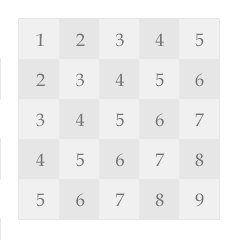51nod 1084 矩阵取数问题 V2
本文共 1193 字,大约阅读时间需要 3 分钟。
51nod 1084 矩阵取数问题 V2
递归式:
if x1 != x2 | dp[step + 1][x1][x2] = max{dp[step][x1’][x2’]} + a[x1][y1] + a[x2][y2] if x1 == x2 | dp[step + 1][x1][x2] = max{dp[step][x1’][x2’]} + a[x1][y1]。 使用step减少空间使用 如图: 初始值: dp[0][x][y] = 0;
初始值: dp[0][x][y] = 0; #include#include #include #include #include #include #include
你可能感兴趣的文章
mysql经常使用命令
查看>>
MySQL经常使用技巧
查看>>
mysql给账号授权相关功能 | 表、视图等
查看>>
MySQL缓存使用率超过80%的解决方法
查看>>
Mysql缓存调优的基本知识(附Demo)
查看>>
mysql编写存储过程
查看>>
mysql网站打开慢问题排查&数据库优化
查看>>
mysql网络部分代码
查看>>
mysql联合索引 where_mysql联合索引与Where子句优化浅析
查看>>
mysql联合索引的最左前缀匹配原则
查看>>
MySQL聚簇索引
查看>>
mysql自动化同步校验_Shell: 分享MySQL数据同步+主从复制自动化脚本_20190313_七侠镇莫尛貝...
查看>>
Mysql自增id理解
查看>>
mysql自增id超大问题查询
查看>>
MySQL自定义变量?学不废不收费
查看>>
MySQL自带information_schema数据库使用
查看>>
MySQL获取分组后的TOP 1和TOP N记录
查看>>
mysql虚拟列表_动态网页制作-官方版合集下载-多特
查看>>
MySQL蜜罐反制获取攻击者信息
查看>>
Mysql表创建外键报错
查看>>